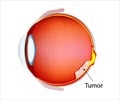A new locally applied treatment for the eye cancer retinoblastoma has been developed by scientists at St. Jude Children's Research Hospital.
A new locally applied treatment for the eye cancer retinoblastoma has been developed by scientists at St. Jude Children's Research Hospital and demonstrated in a mouse model to cause a remarkable reduction in the size of the tumor, without causing the side effects common with standard chemotherapy. In addition the treatment also appears to be suitable for certain forms of breast, lung, prostate and colon cancer, and is simple enough for widespread use even in countries with limited resources.
A report on this work appears in the Nov. 2 issue of the journal Nature.Retinoblastoma occurs in about 5,000 young children worldwide each year, arising from the immature retina, which is the part of the eye responsible for detecting light and color. The cancer is fatal if left untreated.
The new treatment holds promise for a simpler, more effective and less-toxic treatment for retinoblastoma that would eliminate the need for the current, complex therapy, according to senior author Michael Dyer, Ph.D., a Pew Scholar and associate member of the St. Jude Department of Developmental Neurobiology. The treatment is based on a discovery by Dyer's laboratory that overturned a widely held belief about the process of apoptosis (cell suicide) in retinoblastoma. Apoptosis is the way the body rids itself of abnormal cells that might become cancerous or cause other problems.
Until now, retinoblastoma experts thought that a mechanism called the p53 pathway triggered apoptosis in other types of cancer cells, but not in retinoblastoma. However, the St. Jude team proved not only that the p53 pathway was activated in early-stage retinoblastoma, but that excessive levels of a molecule called MDMX blocked it from triggering apoptosis in more advanced tumors. Based on this discovery, the St. Jude team used a molecule called nutlin-3 to block MDMX in retinoblastoma cells in test tube studies as well as in mouse models. The molecule was originally developed by Roche Pharmaceuticals (Nutley, N.J.) for a similar use against a related target called MDM2 in adult cancer cells.
The success in knocking out MDMX with nutlin-3 represents the first example of local delivery of a targeted chemotherapy drug for any childhood cancer, Dyer said.
Targeted therapy uses a customized drug to disable a specific molecule inside a growing cancer cell; local delivery is the placement of a drug at the site of disease, rather than systemic treatment. In systemic treatment, such as chemotherapy, a drug is infused into the body through a vein and then circulates, often causing toxic side effects that are especially challenging in children.
Advertisement
"The findings suggest that this treatment not only could offer children with retinoblastoma more effective and less-toxic treatment," Dyer said. "It could also increase the chance that their vision can be preserved by eliminating the tumor and preventing its spread from the eye to the rest of the body."
Advertisement
This work is likely to have its biggest impact on the care of children with retinoblastoma internationally, according to Dyer. Most children in the United States with retinoblastoma do not die from the disease because they benefit from early detection and advanced medical treatment. The complex treatment includes chemotherapy, radiation and laser therapy, as well as control of infections caused by treatment-related suppression of the immune system. However, most of the 5,000 children worldwide who are found to have retinoblastoma live primarily in countries with limited resources and have restricted access to medical treatment, according to Carlos Rodriguez-Galindo, M.D., an associate member of the St. Jude Oncology department.
"Today, those children do not have access to the advanced treatments available in other countries, such as the United States," Rodriguez-Galindo said, "but our new approach has the potential to make the treatment of retinoblastoma simpler and less toxic. Ideally, these treatments could be administered even in countries that cannot afford the highly complex infrastructure now required to manage children with retinoblastoma. This would mean saving many more lives and preserving more vision." Rodriguez-Galindo is a co-author of the paper.
Retinoblastoma can occur as a unilateral (one eye) or bilateral (both eyes) disease. In the case of unilateral disease, surgeons generally remove the eye that has the cancer in order to prevent the disease from spreading. However, children with bilateral retinoblastoma pose a significant challenge to physicians, who are reluctant to remove both eyes from young children, said Matthew Wilson, M.D., a surgeon in the St. Jude ophthalmology division and a co-author of the paper. In those cases, the physicians institute aggressive systemic chemotherapy to reduce the size of the tumor, followed by one of several possible therapies such as radiation or lasers to destroy the remaining cancer cells in the eye. "When successful, this therapy often saves vision," Wilson said. "Clinicians at major medical institutions generally save 70 percent of all eyes treated, even in the case of advanced disease."
Source-Eurekalert
NLA











